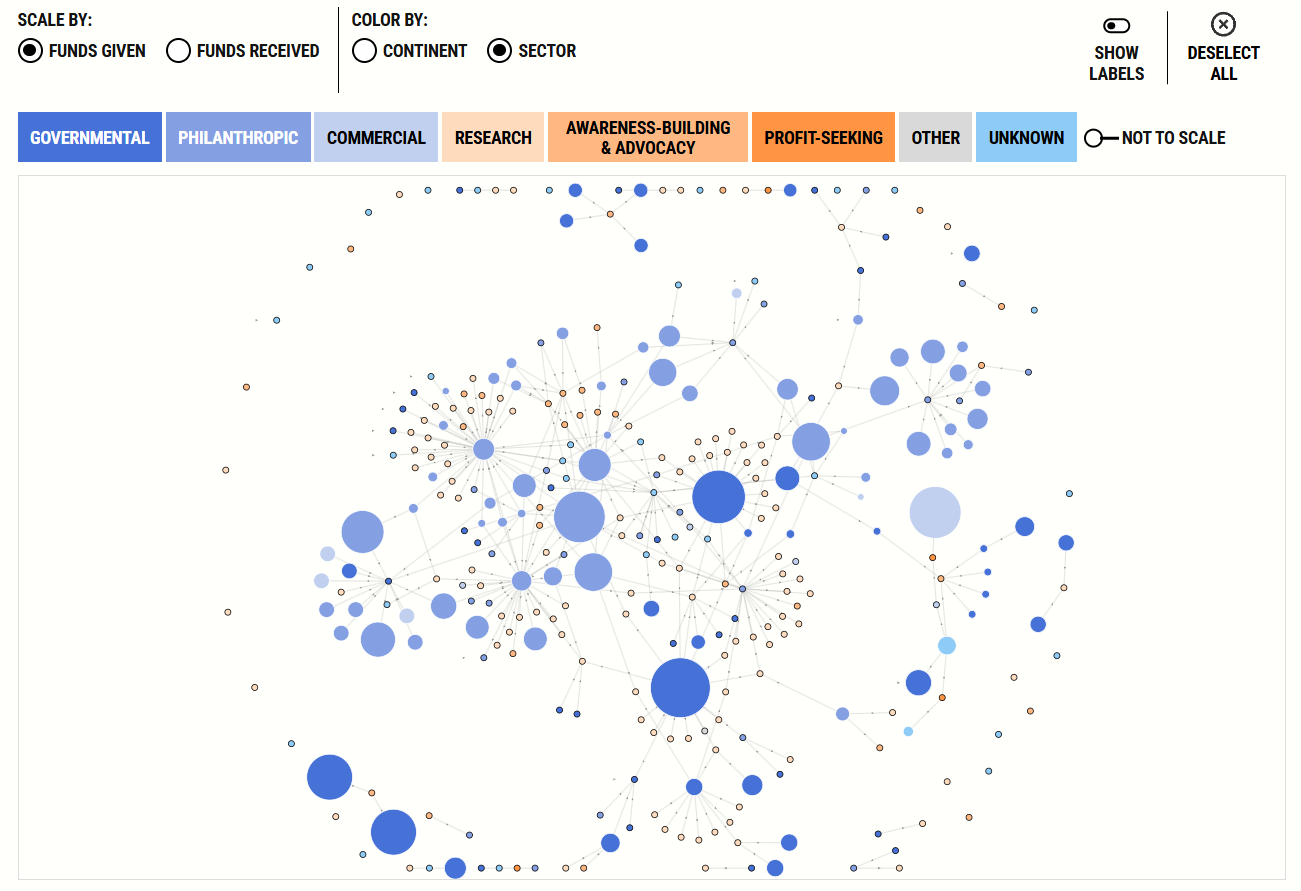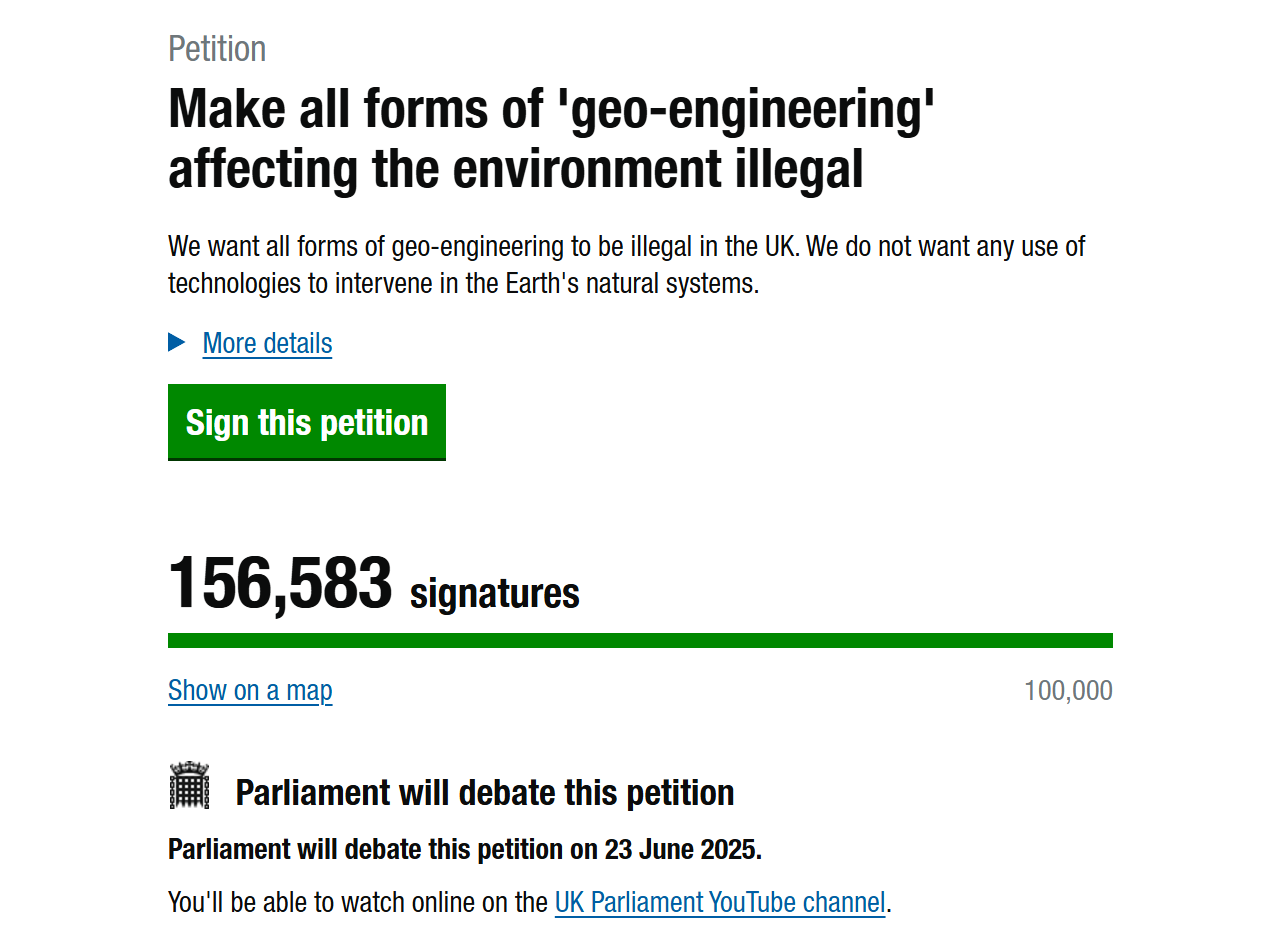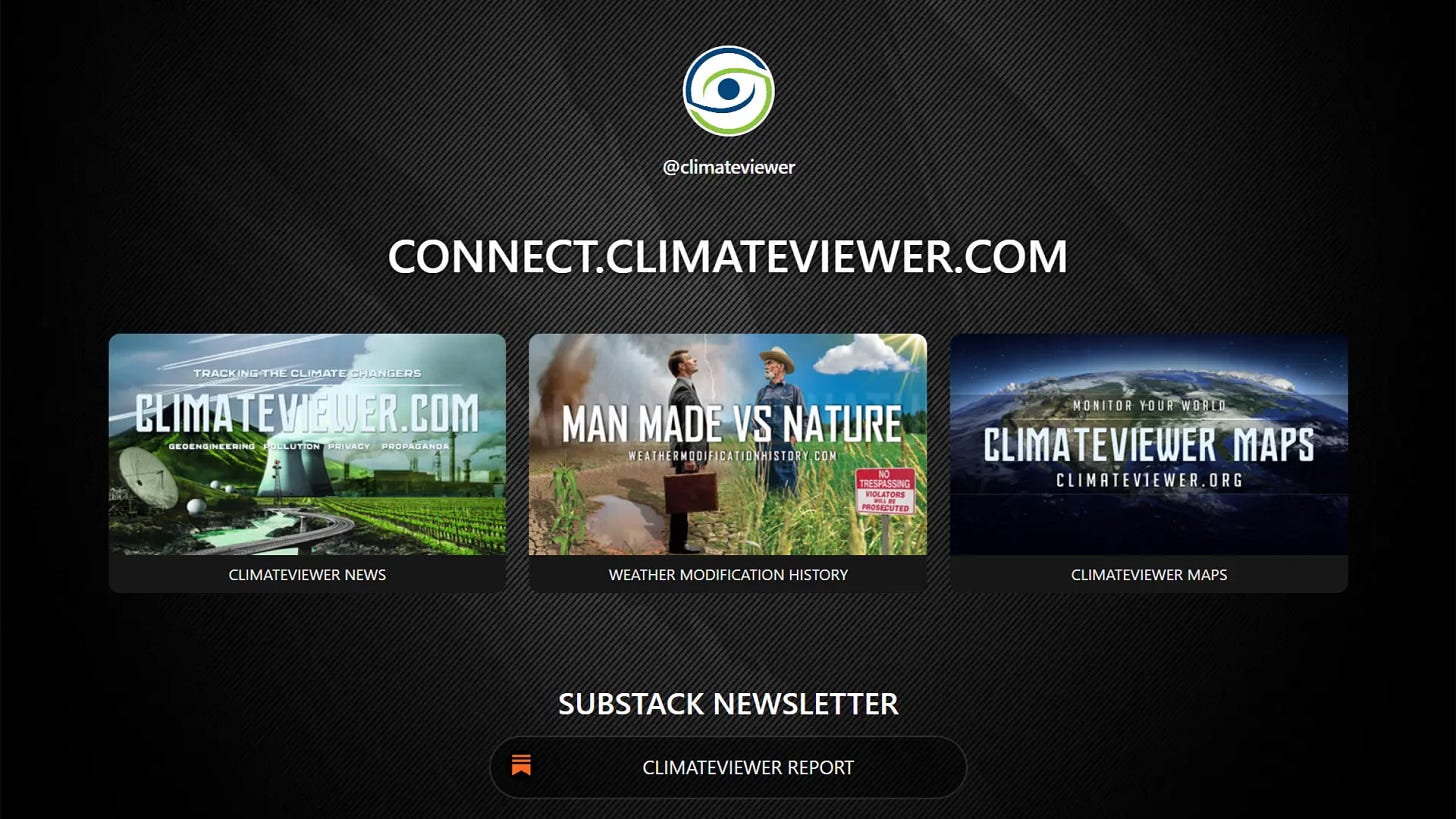UK Geoengineering - Just the Facts!
The United Kingdom's Sun Dimming experiments explained without fear porn.
While the world was hyperventilating over the announcement of the UK’s solar geoengineering, I waited. There wasn’t enough information on what they were actually planning, so I waited even longer. When the funds from Advanced Research and Invention Agency (ARIA) were finally allocated and the announcement of approved projects were posted, I still waited. After reaching out to several geoengineering scientists and activists I trust (both sides), I am finally ready to deliver my verdict.
I am firmly in the camp that geoengineering, specifically solar radiation management (SRM) using stratospheric aerosol injection (SAI), marine cloud brightening (MCB), cirrus cloud thinning (CCT), or more simply put, ANY METHOD OF BLOCKING SUNLIGHT TO COOL THE PLANET SHOULD BE BANNED, INCLUDING RESEARCH INTO SUCH TECHNIQUES.
Nonetheless, the chemtrail people are once again screwing up the ability to even have a real conversation about the seriousness of rallying push-back on geoengineering field experiments and eventual deployment because they are ignorant, scared, and addicted to the fear fed to them by propagandists posing as activists.
This is what ignorance breeds: fear and violence.

Don’t Go Full Retard
Please watch the video posted above on Rumble or YouTube. Now that the full story is known, UK’s ARIA is funding 21 geoengineering projects, of which, 5 will be outdoor experiments. More on those experiments below. For more information on geoengineering funding, check out these studies by SRM360.


What Are The UK’s Five Geoengineering Outdoor Experiments Going to Be?
ONE: Stratospheric Aerosol Injection (SAI) outdoor experiment.
THREE: Marine Cloud Brightening (MCB) outdoor experiments.
ONE: Arctic Geoengineering (ice re-freezing).
While the fear porn pushers are freaking you out over ARIA’s SAI experiment, they claim that they intend to float balloons into the stratosphere in both the US and UK and release no chemicals at all.
Full list of funded experiments available here:
https://www.aria.org.uk/opportunity-spaces/future-proofing-our-climate-and-weather/exploring-climate-cooling/ • Archive
Stratospheric Aerosol Injection (SAI)
Natural Materials for Stratospheric Aerosol Injection
Hugh Hunt, University of Cambridge
Award: £5.5m over 36 months
Team: University of Cambridge | Harvard University | Imperial College LondonStratospheric Aerosol Injection (SAI) is a widely discussed potential climate cooling method, but the most commonly proposed materials (sulfates) carry significant hazards in this context, including potential ozone depletion and toxicity. Addressing whether safer, alternative materials could ever be feasible or effective for SAI is therefore a critical, unanswered scientific question. This project will undertake fundamental research to investigate the properties and behavior of innovative, non-toxic, non-sulfate materials in a very controlled manner.
The research combines laboratory studies and computational modelling with unique and contained material exposure experiments. In these experiments, tiny (milligram) amounts of materials that occur in natural mineral dust (such as limestone, dolomite, or corundum) will be secured onto supports inside the gondolas of specially adapted weather balloons. These balloons are likely to be launched from sites in the USA and/or the UK; the specific site will be determined in line with ARIA’s requirements for community engagement. The balloons will carry the samples into the stratosphere for exposure periods ranging from hours to weeks before performing controlled descent for recovery. Crucially, no materials will be released into the stratosphere; this approach effectively brings the stratosphere to the samples. Studying the recovered samples will reveal how stratospheric conditions affect their properties over time. This foundational science is essential to advance understanding of the potential impacts of SAI and for determining if less harmful alternatives to sulfates might exist (and if they might warrant further study in the context of SAI).
Marine Cloud Brightening (MCB)
Marine Cloud Brightening in a Complex World
Daniel Harrison, Southern Cross University
Award: £1m (potentially rising to £5m with matched funding) over 5 yearsThis project investigates Marine Cloud Brightening (MCB), a potential way to cool specific areas by enhancing cloud reflectivity using a spray of seawater. Building on their experience conducting previous small-scale outdoor experiments in partnership with local communities around the Great Barrier Reef, Australia, this team seeks to deepen our understanding of MCB. While the concept could potentially protect vulnerable ecosystems like coral reefs from heat stress, its real-world effectiveness remains uncertain. This research aims to address this critical knowledge gap by investigating the complex atmospheric dynamics and microphysical processes involved, moving beyond basic principles to assess if, and how, MCB could work safely and effectively.
The research combines advanced computer modelling with the development and indoor testing of sea salt sprayers. If these findings suggest promise, and subject to meeting ARIA’s governance requirements, the project plans to conduct small-scale, controlled outdoor experiments over the Great Barrier Reef in years 3 and 4 of the 5-year project. These outdoor experiments are strictly contingent on prior results, rigorous independent safety reviews, regulatory approvals, and continued co-design and partnership with Traditional Owner groups, local stakeholders, and the broader community of the Great Barrier Reef Marine Park. If approved, these controlled experiments could involve brightening clouds within areas up to 10 km × 10 km, with seawater spraying taking place over 5-6 weeks, for 6 to 8 hours per day. All activities will fully adhere to ARIA's robust governance framework, emphasising transparency, environmental risk minimisation by design, and community engagement. The overall goal is to generate crucial real-world data to determine the effectiveness and risks of MCB, and its potential for protecting vulnerable ecosystems at a regional scale.
A REsponsible innovation Framework for assessing noveL spray tEChnology research To examine local albedo changes from marine brightening and its multi-scale impacts (REFLECT)
Hugh Coe, University of Manchester
Award: £6.1m over 3 years (initial phase)
Team: University of Manchester | University of Cambridge | Archipelago Technology | University of Exeter | Finnish Meteorological Institute | University of LeedsMarine Cloud Brightening (MCB) and Marine Sky Brightening (MSB) – ideas for cooling the Earth by increasing the reflectivity of clouds or the sky using tiny droplets of seawater – depend critically on having the right technology to generate sprays of these droplets effectively. However, the technical feasibility and optimal methods for doing so are poorly understood. This project aims to address this gap by developing and responsibly testing the necessary spray technologies to determine if these approaches could be viable.
Over an initial three-year period, the team will undertake computer modelling, build bespoke sprayers based on the modelling results, and conduct indoor tests. A crucial part of this phase involves beginning collaborative engagement with local communities to co-design potential future outdoor experiments. Any small-scale, controlled outdoor experiments to test sprayer performance would only occur after this initial phase, contingent on further funding, successful co-design demonstrating community engagement and support, and strict adherence to ARIA's safety and governance protocols. These potential tests are expected to be undertaken in the UK (location to be determined). Initial tests, if approved, would be very limited, lasting only a few seconds and creating small plumes of seawater spray just a few hundred metres in size. Only if these initial tests prove successful and safe might later experiments explore brightening larger cloud areas, potentially up to 10 km long and a few hundred metres wide. These tests are inherently benign, replicating natural processes that generate sea spray over the ocean developing spray systems such as those that are already employed to cool crowds with fine mists of water and dampen construction sites to suppress pollution. The overall goal is to establish a robust and responsible experimental framework to assess the technical feasibility and optimal methods for MCB and MSB.
BrightSpark – Cloud brightening with electric charge
Giles Harrison, University of Reading
Award: £2m over 36 months
Team: University of Reading | Menapia Ltd | CelestialFinding ways to influence cloud reflectivity is a key research challenge. This project investigates using controlled electric charge, a natural atmospheric phenomenon, to influence water droplets in fogs and clouds as an alternative to spraying seawater. The research aims to determine if carefully managed electrical charges could offer a safe and effective method for enhancing cloud reflectivity.
The team will investigate the fundamental science of how artificial charge release affects cloud and fog droplets. The project includes plans for very small-scale (on the order of 100 m × 100 m), controlled outdoor experiments in the UK during the third year of the project. These experiments are strictly conditional on demonstrating appropriate levels of community engagement, co-design, and adherence to ARIA’s rigorous safety and ethical governance framework. The core goal is to gather foundational data to assess if this method is viable and safe enough to warrant further investigation.
Glacier Geoengineering
Re-Thickening Arctic Sea Ice (RASi)
Shaun Fitzgerald, Centre for Climate Repair
Award:£9.9m over 42 months
Team: University of Cambridge | University of Manchester | University College London | Nansen Environmental and Remote Sensing Center | Real Ice | Arctic Reflections | University of Washington | Arizona State UniversityThe Arctic is warming much faster than the global average, leading to dangerous sea ice loss with far-reaching consequences. This project investigates whether deliberately thickening sea ice during winter could be a viable way to slow summer melt, reduce Arctic warming, and mitigate further ice loss. The research aims to provide critical data on the feasibility, scalability, potential ecological impacts, and overall effectiveness of this approach, which involves accelerating natural freezing processes using seawater from underneath the ice.
Researchers will conduct controlled, small-scale experiments in Canada across three winter seasons (2025-26 to 2027-28). The process involves pumping seawater from beneath existing ice and spreading it on top, where the frigid air freezes it quickly, creating thicker ice patches. Over the course of the project (and if the early experiments suggest the approach is ecologically sound), later experiments will aim to cover areas up to 1 km² per experiment site. The key questions are whether this thicker ice lasts longer into the summer, how it might affect ice movement, and what the local ecological impacts are. These experiments will be conducted in close collaboration with local communities and under ARIA's stringent governance framework, prioritising safety and environmental monitoring. The goal is to gather essential real-world data to rigorously assess if this intervention warrants further consideration.
Other Video References
UK Parliament to Debate Geoengineering
Parliament will debate this petition on 23 June 2025.
You'll be able to watch online on the UK Parliament YouTube channel.


Connect With ClimateViewer
Check out my websites, Telegram chat, video platforms, social media, and other ways to support my work on connect.climateviewer.com.

Attack Ideas, Not People. ❤️ you, mean it.


Man shouldn't be missing with the weather period.
What about the big little fact that there are massive unknowns? Nobody knows how this will go. The whole solar system exquisitely evolving in beauty for millions of years and along comes a corporate think tank with a slew of chemicals to correct the situation? What absurd hubris to propose that we can air condition the planet with chemicals.
I think the tech bros just want to further destroy the natural environment for their transhuman cyborg agenda.